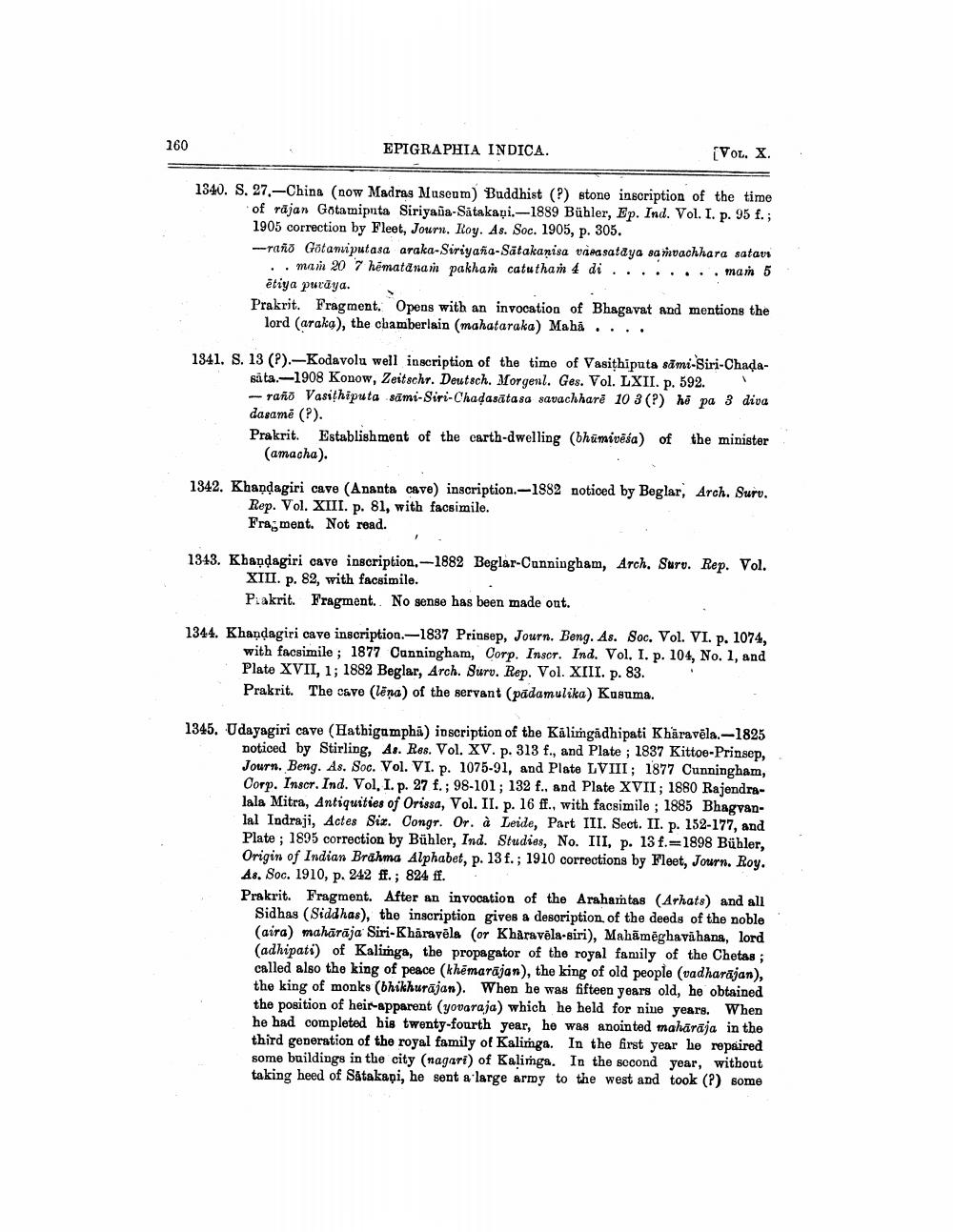________________
260
EPIGRAPHIA INDICA.
Vol. X.
:
1340. S. 27,-China (now Madras Museum) Buddhist (?) stone inscription of the time
of rajan Gotamiputa Siriyana-Satakapi.-1889 Bühler, Ep. Ind. Vol. I. p. 95 f.; 1905 correction by Fleet, Journ. Roy. As. Soc. 1905, p. 305. -raño Götanuputasa araka-Siriyana-Satakanisa vàoasataya sa nachhara sataus
. . mam 20 7 hématānam pakham catuthan 4 di ........ mam 5
ētiya purūya. Prakrit. Fragmont. Opens with an invocation of Bhagavat and mentions the
lord (araka), the chamberlain (mahataraka) Mahi ....
1341, S. 13().Kodavolu well inscription of the time of Vasithiputa sămi-Siri-Chada
sata.-1908 Konow, Zeitschr. Deutsch. Morgenl. Ges. Vol. LXII. p. 592. -raño Vasithiputa sāmi-Siri-Chadasāta sa savachharë 10 3 (?) hi pa 3 diva dasamē (?). Prakrit. Establishment of the earth-dwelling (bhūmivēša) of the minister,
(amacha)
1342. Khandagiri cave (Ananta cave) inscription.-1882 noticed by Beglar, Arch. Suru.
Rep. Vol. XIII. p. 81, with facsimile. Fragment. Not read.
1343. Khaņdagiri cave inscription.-1882 Beglar-Cunningham, Arch. Surv. Rep. Vol.
XIII. p. 82, with facsimile. Prakrit. Fragment. No sense has been made out.
1344. Khandagiri cave inscription.-1837 Prinsep, Journ. Beng. As. Soc. Vol. VI. p. 1074,
with facsimile; 1877 Canningham, Corp. Inscr. Ind. Vol. I. p. 104, No. 1, and Plate XVII, 1; 1882 Beglar, Arch. Surv. Rep. Vol. XIII. p. 83. Prakrit. The cave (lēna) of the servant (padamulika) Kusuma.
1345. Udayagiri cave (Hathigamphā) inscription of the Kalimgadhipati Kharavēla.-1825
noticed by Stirling, As. Res. Vol. XV. p. 313 f., and Plate ; 1837 Kittoe-Prinsep, Journ. Beng. As. Soo. Vol. VI. p. 1075-91, and Plate LVIII; 1877 Cunningham, Corp. Inscr. Ind. Vol. I. p. 27 f.; 98-101; 132 f., and Plate XVII; 1880 Rajendralala Mitra, Antiquities of Orissa, Vol. II. p. 16 ff., with facsimile ; 1885 Bhagvanlal Indraji, Actes Siz. Congr. Or. à Leide, Part III. Sect. II. p. 152-177, and Plate ; 1895 correction by Bühler, Ind. Studies, No. III, p. 13 f.-1898 Bühler, Origin of Indian Brahma Alphabet, p. 13 f. ; 1910 corrections by Fleet, Journ. Roy. As. Soc. 1910, p. 242 ff.; 824 ff. Prakrit. Fragment. After an invocation of the Arahamtas (Arhats) and all
Sidhas (Siddhas), the inscription gives a desoription of the deeds of the noble (aira) mahārāja Siri-Kharavēla (or Kharavēla-siri), Mahāmėghavahang, lord (adhipati) of Kalimga, the propagator of the royal family of the Chetas ; called also the king of peace (khēmarājan), the king of old people (vadharajan), the king of monks (bhikhurajan). When he was fifteen years old, he obtained the position of heir-apparent (yovaraja) which he held for nine years. When he had completed his twenty-fourth year, he was anointed mahārāja in the third generation of the royal family of Kalimga. In the first year he repaired some buildings in the city (nagari) of Kalimga. In the second year, without taking heed of Satakapi, he sent a large army to the west and took (?) some




